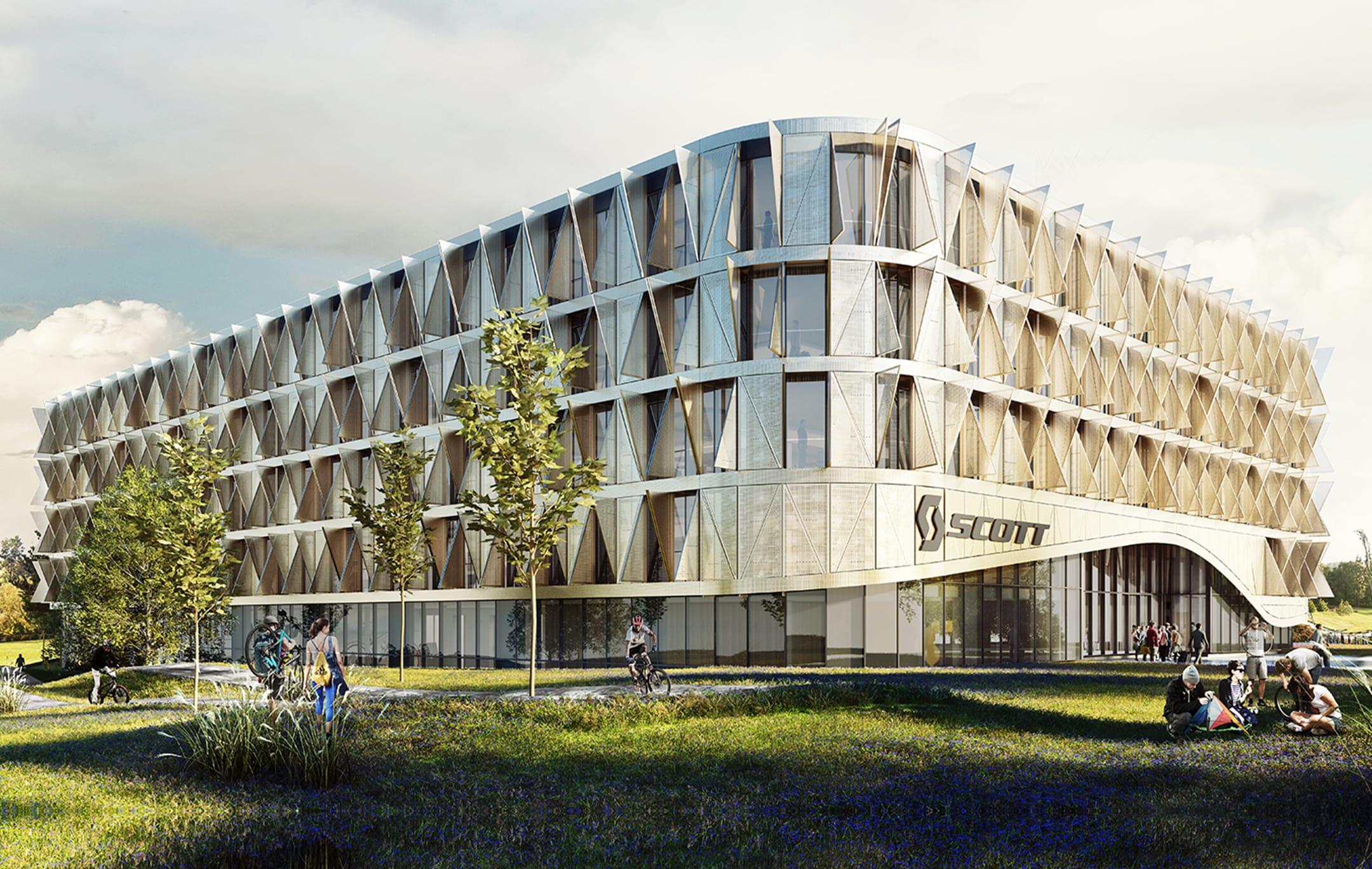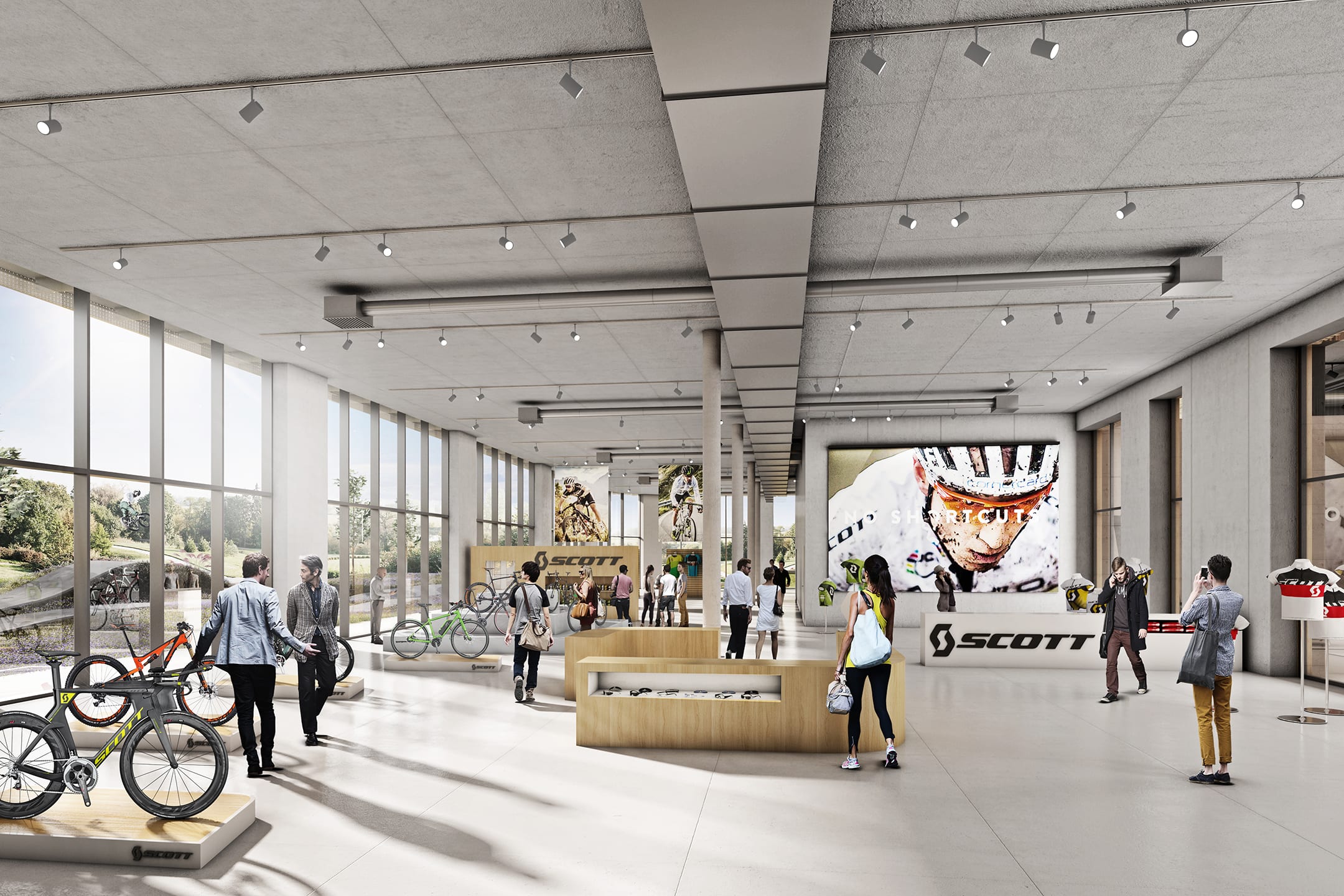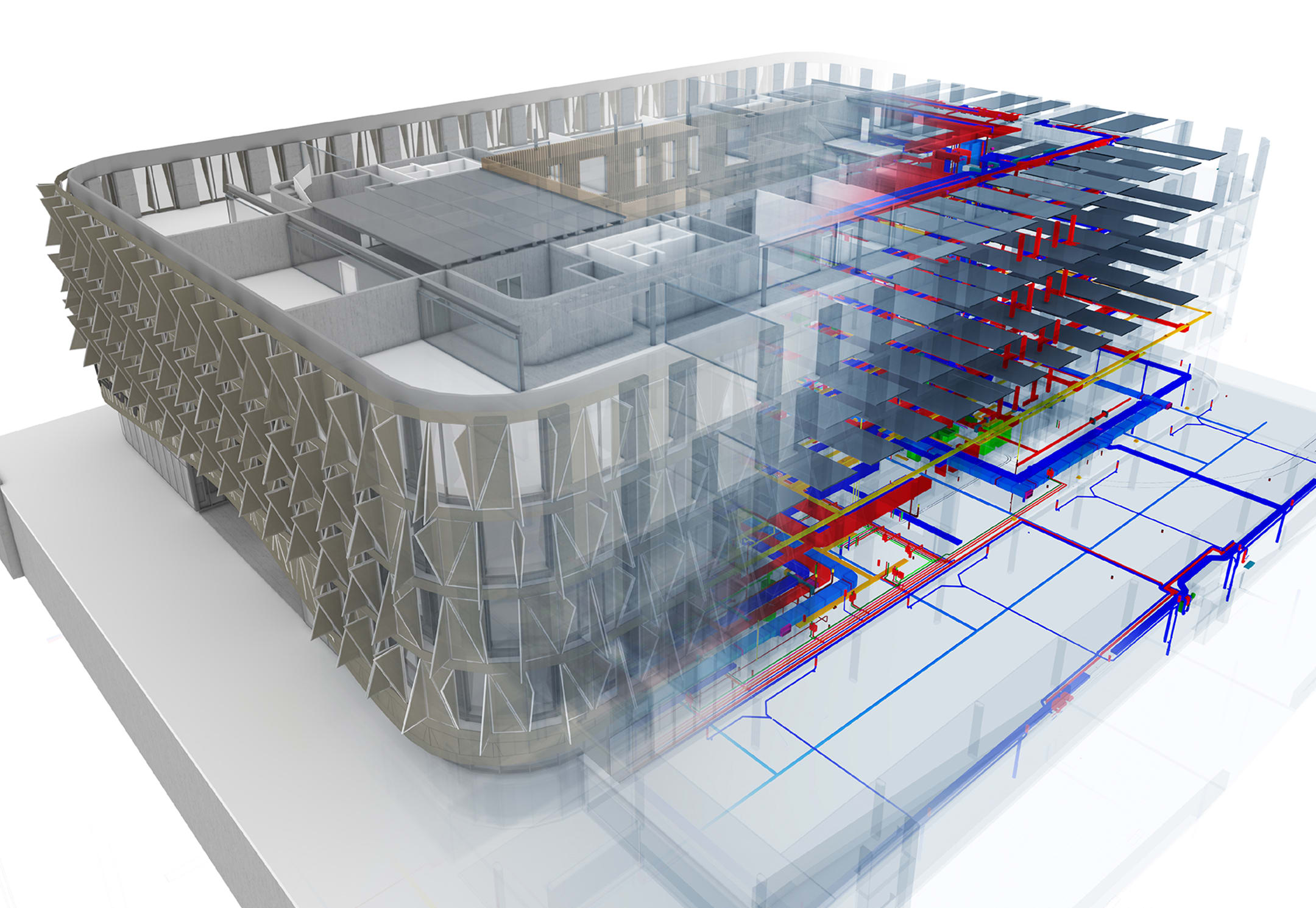
When you meet architectural office and general contractor IttenBrechbühl AG, you’ll find approximately 320 employees who are able to realize large and complex buildings from basic design to commissioning. With over 300 hospitals built worldwide, IttenBrechbühl is particularly strong in the healthcare sector, but also in other sectors such as education and research, transport, and industrial services. The office has a total of 11 locations based in Switzerland, Germany, and Luxembourg.
In 2016, IttenBrechbühl won the Arc Award BIM in Gold with the construction of the large-scale research facility SwissFEL of the Paul Scherrer Institute. A year later, the firm repeated this success with the headquarters of Scott Sports in Givisiez, which is posed to receive the Arc Award BIM in Gold. The sporting goods manufacturer has been based in Fribourg, Switzerland, since 1978. The new company headquarters is poised to represent the innovative power of the company responsible for offering bikes, winter-sports gear, and athletic apparel.
IttenBrechbühl designed the Scott Headquarters with a BIM process similar to other new buildings in Switzerland. IttenBrechbühl gained their first experience with BIM with the SwissFEL, and the aim was similar to the 2016 project: to achieve forward-looking, precise design based on improved communication and coordination between those involved in the process — all on the basis of 3D models. The experience of using BIM for SwissFEL was particularly important for structuring the 3D BIM model at Scott Headquarters: the naming and structure of levels and classes, stories, the definition of the zero point, the handling of IFC data, as well as wall and door styles and symbols used.
Data Exchange via IFC
As with any BIM project, the objectives for Scott Headquarters were initially set out in a project delivery plan. The entire 2D documentation was created with the BIM models; the focus was on quality assurance and interdisciplinary coordination. Model-based quantity takeoffs were also included, with the most important prerequisite being a smooth data exchange. IttenBrechbühl relies on the open file format IFC (SN EN ISO 16739), which can translate data as well as 3D geometry. In order to avoid unexpected surprises, the IttenBrechbühl project team exchanged test files in the IFC format between the different software of the consultants involved, including Basler&Hofmann West AG (HLKS) and Eproplan AG (E), who work with Plancal nova MEP design software, before the actual planning.
As project manager for Scott Headquarters, Tima Kamberi defined the objectives of the BIM planning, supervised the planning process, coordinated the consultants involved and chaired the coordination meetings. Meanwhile, Sandro Ryf and Susanne Keller took over the tasks of BIM coordination — in this capacity they built the 3D architectural model, which served as a reference model for the other models for structural analysis, building services, etc. Ryf sees it as an advantage: with BIM planning, one develops projects in a true material-rich 3D model. This process demands finding spatial solutions for the more complex aspects of the project, which has traditionally been overlooked in 2D sketching.
"I appreciate the freedom of choice that Vectorworks gives me."Sandro Ryf, CAD Systems Administrator at Ittenbrechbühl

"For the 'special corners' I have the possibility to use the general modeling tools of Vectorworks instead of the given parts and to design my own element freely in 3D," Ryf explained.
Ryf therefore does not regard designing with BIM as a restriction of his creativity — it’s actually the contrary. Susanne Keller uses Vectorworks and Solibri Model Checker. She sees a considerable benefit of BIM in checking coordination: "In Solibri Model Checker, our reference model can be merged with the domain-oriented models and checked,” she said. “The automatic collision check provides information for quality improvement. More importantly, I can navigate freely in the project to view critical areas, check recesses, check heights, etc."
In the project development phase, coordination meetings with engineers took place at consistent intervals and were recorded at an early stage. The models, such as the building services model created in Plancal nova and the architectural model created in Vectorworks, were exchanged in IFC format before the meetings so that they could be checked before the meeting. If the architects detected collisions, inconsistencies, or rule violations between their reference model and the model of the engineers, they were logged in Solibri Model Checker in the BIM Collaboration Format (BCF).
"BIM has upgraded the work and competence of the draftsman as a whole. Those who model and inform know more about the project than if they drew a 2D plan.”SUSANNE KELLER, ASSOCIATE PROJECT MANAGER AT ITTENBRECHBÜHL
The BCF log files record, for example, rule violations together with the affected components, the responsible project teams, an appointment, and suggestions for solving the problem. The IttenBrechbühl team sends the BCF file to the responsible consultant before the coordination meeting, where they all open the BCF file in their respective BIM software. A click on the BCF entry directs the responsible party to the point in the model where the coordination error occurs. For example, if the ventilation shaft and the door collide, he can check possibilities for collision resolution before the meeting, saving valuable collaboration time. The architects and the other participants proceed in the same way with their trades. The session itself then serves to find solutions and decisions. "Instead of problems, everyone goes back to their offices with solutions. This is a great step forward compared to the past, which makes the project more fluid overall," said Keller.
"We consistently apply the BIM method to all our new buildings, because we are convinced that this model of cooperation will become widely accepted.”Christoph Arpagaus, Partner and Head of the Bern Office at Ittenbrechbühl
The Benefits of the BIM Process
Marc Pancera, head of BIM at IttenBrechbühl, introduced new internal teams to designing with BIM, which emphasizes the advantages of communication via models — a workflow that avoids misunderstandings that can arise from 2D drawings. "Not only does the time-consuming writing of minutes after meetings go away, but also I notice that both architects and consultants have a higher level of knowledge about the project,” said Pancera. “I attribute this to the fact that problems are solved directly at the meetings and do not have to be examined in the office afterwards."
For Pancera, the BIM method means thinking from the perspective of the entire project team and not just that of the architect. In other words, using BIM via Vectorworks can help enhance IttenBrechbühl's reputation as a key consultant in the planning process.

Pancera then takes these lessons learned a step further by coordinating with BIM experts at authorized Vectorworks distributor ComputerWorks to create internal training courses for project managers and employees.
Christoph Arpagaus, member of the management board, explained how the possibilities of the BIM method can also go beyond 3D design. He sees BIM as a new form of cooperation, in particular project coordination and the exchange of information — two areas in alignment with the goals of the Scott Headquarters BIM project.
With the help of a BIM process, architects at IttenBrechbühl are now re-establishing themselves as directors of a project, holding the threads of the entire planning in their hands with their reference model. This is by no means a question of company size. It is only a question of the know-how and the BIM competence of employees and management, a reality that is certainly attainable.
Stay in the know with the latest insights
Subscribers receive news, customer stories, success and learning tips, event information, and other important announcements from Vectorworks.
By submitting this form, you agree that Vectorworks, Inc. and its authorized partners may contact you in regards to news, offers, and the use of our software, services, and platforms. Learn more about our privacy practices and your data on our privacy page.*